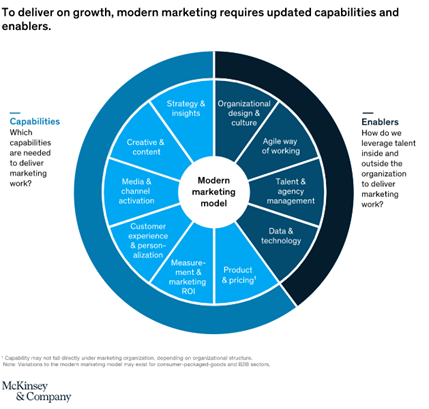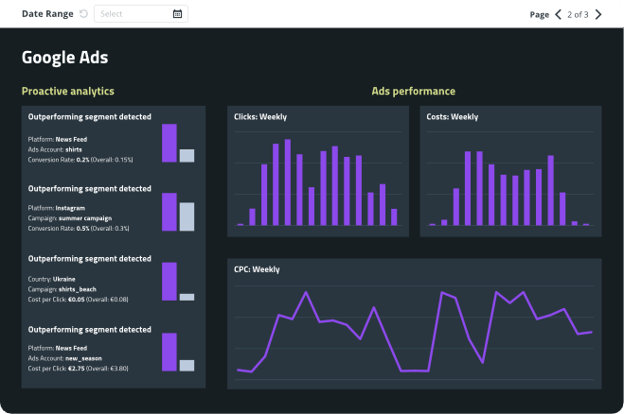Moving one step forward from just tracking KPIs to dashboards that show future outcomes, based on the intelligence behind the data, may be the only true remaining competitive edge a marketer can get in this day and age.
Data and analytics unquestionably drive revenue growth, providing insights across the business to better understand the performance and the necessary contributions attributed to the company’s revenue.
Setting up a marketing dashboard makes it easier to decode this data in order to use the analytics effectively. But this is no walk in the park. Businesses not only have to capture this data, but have to manually create an interface that translates this complex data into actionable insights. A study conducted by Forrester found that 74% of businesses aim to be “data-driven,” but only 29% understand how to connect analytics to action.
So clearly, there’s a disconnect between the gathering of data and displaying it in a consolidated marketing dashboard.
What is a marketing dashboard?
At its core, a marketing dashboard pulls data from multiple sources and displays it in a single location using dynamic visual aids. It can give an at-a-glance summary that quantifies how campaigns are performing and the overall marketing impact on a business.
There are a couple of reasons why marketers should be using a marketing dashboard.
1. Get a bird’s eye view
A marketing dashboard visually summarizes all the important KPIs you have selected to measure, and helps you to holistically understand how well your marketing efforts are performing. This can be in real-time, from lead generation on your website to engagement on social media. Not only can you identify how individual campaigns are performing, but you’ll also be able to monitor how well your overall marketing strategy is performing.
2. Save time
A lack of reporting tools leads to flawed decisions. Instead of manually printing out reports and spreadsheets to analyze the performance of marketing campaigns individually, you can simply refer to your online marketing dashboard that gives you a comprehensive overview of the key metrics you’re tracking.
3. Make more informed business decisions
Being able to see how your marketing campaigns are performing allows you to optimize your tactics and make more informed decisions quicker. This can reduce the cost of your marketing efforts and improve their impact on revenue.
4. Improve visibility across the organization
One of the challenges of running a business is ensuring that different teams are on the same page. If everyone has access to your marketing dashboard, different teams will be able to keep tabs on what’s working and what isn’t, and makes it easy for company-wide communication to take place.
5. Prove the ROI of marketing
A well-built dashboard will be able to show you where your marketing efforts stand and demonstrate the return on investment. You won't only understand the key factors driving ROI, but you can also identify ways to improve it, to ensure that every penny that's spent is resulting in a substantial return.
What insights can you expect to see in a standard marketing dashboard?
Depending on the goals of your company and marketing activity metrics, a good marketing dashboard generally include:
-
Traffic sources
This will tell you who’s visiting your website, and where they’re coming from. This is one of the key metrics to look into when trying to understand how your website is performing. Traffic sources can include email marketing, paid search, social media, organic search and direct traffic. Once you spot what’s driving the most traffic to your site you can improve the messaging and positioning of your products.
-
Click-through rates
You want to be able to understand how effective your marketing outreach campaign was, and you can do this by measuring your CTA’s click through rates. This metric will tell you how many times the call-to-action has been clicked on, and how many of these clicks have led to further action eg: signing up for a free trial or converting into a paying customer.
-
Bounce rates
Your bounce rates are an important KPI to measure to understand the effect your messaging has on potential customers. Bounce rates tend to change over time, but will allow you to analyze how your content is performing. A higher bounce rate means that your content does not resonate with your audience and needs to be updated, whereas a low bounce rate means that your users are engaging with your content.
-
Social media engagement
Many businesses place importance on the number of followers and likes they receive on social media. But it’s more important to create a strong connection between you and your followers. This includes building an audience that is loyal, interacts with your brand and responds to your CTAs. Measuring the level and the quality of engagement will allow you to understand what topics drive the most traffic, and can be used to improve your social media strategy.
-
ROI
This is probably one of the most important metrics to track within the marketing function. This metric will ultimately make it easier for you to manage existing campaigns, evaluate their success, and plan future marketing strategies. Knowing your marketing ROI will help you demonstrate the value of your campaigns to the rest of the business.
Why do standard marketing dashboards not meet the needs of modern marketers?
It has become increasingly evident that marketing technology is evolving, and marketing reporting has indeed gotten more complicated. However, modern analytics and BI tools have been built to handle the needs of today’s marketers.
From creating dashboards to understanding the results, marketers find themselves relying on data analysts to get the insights they need. However, in recent years, the focus is shifting to an easy to use, and self-service approach, to enable marketers to stand on their own two feet and quickly find the best insights, without the reliance on data scientists.
A study conducted by McKinsey states that in order to “drive growth in the digital age, marketing needs to modernize a specific set of capabilities and mindsets.” It found that most organizations have realized the importance of continuously advancing within the martech space, but don’t understand what this means for the workforce and how they can collectively integrate their data systems.

Alarmingly, spreadsheets are still a common fixture of marketing reporting, and as data volumes continue to grow, integrated marketing analytics is crucial to getting the most out of your datasets.
Although most businesses are still behind the curve, most of them acknowledge that raw, fragmented data must be turned into smart business insights.
Move to a more proactive approach
Turning your marketing data into smart insights is every marketer’s dream. It’s the moment of deriving true value from your once messy dataset. But traditional marketing analytics tools pose complex limitations that cause marketers to struggle to answer questions and have them turn to data analysts and scientists to answer these questions.

These limitations include:
-
Real-time data ingestion and limitations
You can easily get lost in the abundance of data you currently have. So many tiny, but potentially impactful opportunities for improvement can easily be overlooked. Also, a tiny human error can cost your company lots of money and bring you, personally, a lot of frustration.
-
Manual analysis
In a standard approach to data analysis, the steps are pretty complex– you download the data you require, ensure that it’s not corrupted, and send it to your analytics tool for further analysis. This is time-consuming and involves a lot of manual work.
-
Speculative estimations
From a holistic perspective, marketers want to be able to understand what has already happened, but are unable to take a glimpse into what will come in the future, and are forced to speculate the outcome and forecast of existing marketing campaigns.
Adverity’s proactive analytics features enrich your existing marketing dashboards with machine learning and AI, to help with insight generation and explanation. Our platform uses AI power to automatically find the most critical insights for you, and proactively present them in an unbiased and easy-to-understand way. Marketers can now understand how to reallocate their budgets and fine-tune campaign performances, and as a result, see where they need to reduce spend and where to increase it in order to achieve maximum potential revenue.
Standard marketing reports are more time-consuming to create and digest as compared to modern marketing reports. Adverity’s proactive analytics differs from traditional reports and offers three key advantages over conventional reports:
-
Automated insights at your fingertips
Uncover deep insights that conventional analytics approaches can miss and significantly decrease the time to discover them. This allows marketers to identify patterns and detect anomalies as they happen so opportunities are not missed, and hidden issues are revealed before becoming a problem. -
A high level of data analysis
Automate analysis in a much shorter space of time and identify problems with data quality without reliance on data scientists. This helps marketers to create forecasts by learning from historical data, looking at current spend, and predicting future short-term spend to help achieve optimum use of budgets. -
Proactive recommendations
It also provides cross-channel optimization by analyzing historical spend and revenues, and recommending reallocation of budgets, to understand where to focus resources.
Proactive analytics provides much greater insights than standard analytics tools and methods, giving marketers a crucial competitive edge. It enables the whole team to make insightful decisions quickly, which allows them to correct the focus of campaigns, quickly grasp opportunities for greater performance, and achieve maximum returns without the risk of overspending.
Brands and agencies can make use of this product; they can discover much faster, actionable insights within enormous amounts of data. Proactive analytics provides greater granularity and depth of insights, which may have been missed previously, so they can develop more effective strategies. It also enables them to optimize budget spend, while maximizing ROI, allowing them to demonstrate a much higher level of value.
In order to become a performance-driven organization fueled by data and insights, you need to have better data management processes in place that connect all of your data from different sources, consolidates it into a central location, and transforms it into an easy-to-digest format that helps you discover hidden opportunities, trends, and anomalies.
Leveraging the right technology
Given the limitations of traditional marketing analytics tools, marketers need to urgently invest in the right technology. However, simply investing isn’t enough – organizations need to take the next step in connecting analytics to action and enable them to resolve unseen issues quicker, and maximize the ROI of all marketing activities. Intelligent marketing dashboards that visualize data in an easy-to-digest way, and solutions designed to clean data are just two of the comprehensive tools that organizations can leverage to ensure that the overall business strategy, and its execution, is successful.














